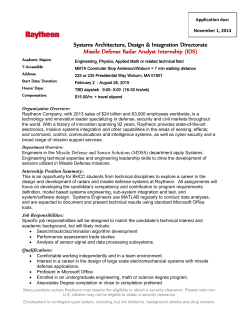
Link to Download/Print Version - Missile Defense Advocacy Alliance
U.S. MISSILE DEFENSE SENSORS MDAA SYSTEM BRIEF #2 MARCH 2015 A robust system of sensors that can track and discriminate missile threats is the bedrock of a capable BMD system. THE UNITED STATES HAS AN EXTENSIVE NETWORK of radars across the globe and satellites in orbit for the tracking and discrimination of ballistic missile threats to the U.S. homeland, our deployed forces and allies. Gaps still remain, and improving this network of sensors with new technologies such as a new Long Range Discrimination Radar to detect threats to the homeland have become a top priority for the United States. Despite often getting less attention System Needs: than missile defense interceptor systems, sensors are equally • Long Range Discrimination Radar important to ensure a robust (LRDR) for better discrimination of warheads from debris and defense against ballistic missiles. decoys for U.S. homeland BMD. You cannot hit what you cannot see. Beyond just alerting us to the threat, • Advanced Missile Defense Radar (AMDR) to enhance tracking sensors discriminate between lethal capabilities of Aegis BMD ships. warheads and decoys and debris. Sensors feed tracking data to the • Patriot BMD system radar upgrades interceptors, guiding them to their to incorporate MSE interceptor. targets. BMD sensor systems have more applications beyond missile defense - they provide tracking of other airborne threats such hostile aircraft and UAVs. [1] • Upgrades to Aegis Baseline 9 software to more efficiently process data from AN/SPY-1 radars and engage multiple threat types. Cobra Dane Early Warning Radar Shemya, Alaska MDAA System Brief #2 Missile Defense Sensors SENSOR SYSTEMS v AT A GLANCE DSP and SBIRS Satellites detect heat signatures of enemy missile launches. Geographic Distribution Sea-Based Sensors Persistent sensor coverage is a limited military resource, and the United States has focused its BMD sensor assets in regions where the threat is the greatest, such as the northern Pacific, and the Middle East. Sea-Based Sensors include the Sea Based X-Band Radar (SBX), and the AN/ SPY-1 S-Band radars onboard Aegis BMD Ships. The SBX is a mobile sensor built on a floating oil platform that provides high resolution tracking of missile threats over the Pacific Ocean, and has been critical during tests of the U.S. homeland missile defense system. Land-Based Sensors Patriot Radars: Integrated into a Patriot Missile battery, these radars provide targeting of short and medium range missiles during terminal phase, but are never deployed independently. A/N TPY-2 Radars provide easily transportable X-Band radar coverage, either independently or in direct support of a deployed THAAD Battery Sea-Based X-Band Radar (SBX), a mobile platform that provides tracking and discrimination U.S. land based sensors include the family of Upgraded Early Warning Radars (UEWR), TPY-2 X-band radars, Patriot Radars and JLENS. The UEWRs are among the oldest, originally put in place to detect missile launches from the USSR over the North Pole during the Cold War. These radars have been upgraded over the past decade, and modernization is still ongoing at the radars in Cape Cod and Shemya. AN/TPY-2 X-Band radars are among the most advanced in the world, providing high quality surveillance and tracking from deep within hostile airspace. The U.S. has six TPY-2s deployed overseas in Israel, Turkey, Qatar, Guam, and two in Japan. AN/SPY-1 radars are deployed onboard 33 U.S. Aegis BMD ships in Japan, the Arabian Gulf, the Mediterranean, Hawaii, and the U.S. East and West Coasts. In addition to their function within Aegis BMDS, they also provide tracking for the U.S. homeland missile defense. Space-Based Sensors U.S. DSP and SBIRS satellites detect the heat signatures of missiles launches, and alert the land and sea based sensors to the threat. In addition to their role in missile defense, they have other applications in global security. For example, these sensors were used to confirm that a ground launched anti-air missile caused the downing of Malaysian Airlines flight 17 over Ukraine in July 2014. A/N Spy 1 Radars onboard Aegis BMD Ships provide sea-based tracking for regional and homeland defense. Upgraded Early Warning Radars (UEWR) provide additional sensor coverage and tracking for U.S. homeland defense. Joint Land Attack Elevated Netted Sensor (JLENS) offers wide area detection of threats such as cruise missiles and UAVs. [2] Current Disposition of AN/SPY-1,TPY-2, SBX, JLENS and UEWR Radars MDAA System Brief #2 Missile Defense Sensors Tracking Better Sensors = Reliability Tracking is the capability to know where an enemy missile is at all times. Having robust tracking is vital in order to guide the interceptor to a position where it can destroy the missile. Multiple systems play a role in tracking including overhead satellites, sea and ground based radars. The quality and completeness of BMD sensors coverage has a direct impact on the reliability of the BMD interceptors. Persistent tracking means the interceptors will be guided accurately to the target missile. Robust discrimination means that interceptors will not wasted on non-lethal objects such as decoys or debris. Discrimination When an enemy warhead separates from a missile booster in space, it creates a “cloud” of debris, which can include decoys designed to fool defense systems. Discrimination is the ability for the interceptor to determine which objects in the cloud are lethal, and which are not. The ability to track and discriminate is determined by the sophistication and completeness of radar coverage and the sophistication of the seeker onboard the Kill Vehicle. Want to know more about BMD Sensors? FUTURE SENSORS Long Range Discriminating Radar would add much needed tracking and discrimination for the U.S. homeland missile defense system, and close many of the sensor gaps that currently exist. This vital program is under threat from the Budget Control Act. Visit MDAA’s website at www.missiledefenseadvocacy.org or contact Ian Williams at iwilliams@missiledefenseadvocacy.org Advanced Missile Defense Radar will provide wide-area volume search, tracking, Ballistic Missile Defense (BMD) discrimination, and missile communications, and will be equipped onboard the Arleigh-Burke Flight III Aegis BMD Destroyers. Space Based Infrared System (SBIRS) L-Band, S-Band, X-Band? These designations refer to the frequencies and wavelengths of energy emitted by the radars. Higher frequencies will produce crisper imagery. Generally, a crisper, higher fidelity image means that the radar will provide greater discrimination capability. The L, S and X Bands are the most commonly used for radars. The LBand has the lowest frequency of the three, and can be used to track and classify airborne threats. S-Band is a higher frequency, and can be used for tracking, classification, fire-control and some discrimination. X-Band, the highest frequency, produces a high-fidelity image, can track many objects and provides a high degree of discrimination. L-Band Radars • Upgraded Early Warning (UEWR) Radars S-Band Radars • AN/Spy-1 (Aegis) X-Band Radars • AN/TPY-2 • Sea Based XBand (SBX) • Cobra Dane Radar Lists of radars not exhaustive [3] MDAA System Brief #2 Missile Defense Sensors
© Copyright 2025










